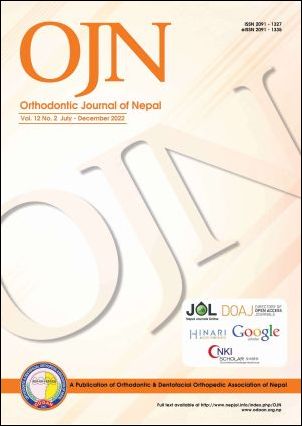Assessment of Maxillary First Molars Rotation in Class II malocclusion cases: A Cross Sectional Study
DOI:
https://doi.org/10.3126/ojn.v12i2.49771Keywords:
Class II malocclusion, Line of Ricketts, Molar rotationAbstract
Introduction: Determination of malocclusion including individual tooth malposition is crucial during diagnosis and treatment planning. Along with anteroposterior mal-relation, there is often the rotation of upper first molars in Class II cases. Rotated molars not only occupy more space than normally positioned molars but also increase the challenge for orthodontic treatment.
Aims and objectives: This study aimed to determine the prevalence and extent of maxillary molar rotation in Class II division 1 and 2 malocclusion cases.
Material and Methods: A total of 142 pretreatment maxillary casts of Class II malocclusion (71 division 1 and 71 division 2) cases were collected from the Department of Orthodontics of People's Dental College and Hospital. All the casts were scanned at a 1 200 dpi resolution with teeth touching the glass of the scanner (brother MFC-L2700DW model). Scanned pictures were then printed without any change in magnification. Measurement was made on those printed copies of casts. To determine the rotation and its severity a method developed by Ricketts (Line of Ricketts) was used. Descriptive analysis was carried out in Microsoft Excel 2013.
Result: In Class II division 1 cases, 45 (63.4%) had right molar rotation and 47 (66.2%) had left molar rotation. In Class II division 2 cases, 33 (46.5%) had right molar rotation while 34 (47.9%) had left molar rotation. Similarly, the mean rotations of the right and left molars in division 1 were 6.24 mm and 6.77 mm respectively and those in division 2 were 4.82 mm and 4.94 mm respectively.
Conclusion: The prevalence and extent of rotation of maxillary molars in Class II divisions 1 and 2 malocclusion cases were assessed in this study. Mesiopalatal rotation and left molar rotation were observed more commonly in both divisions.
Downloads
Downloads
Published
How to Cite
Issue
Section
License
Copyright (c) 2023 Orthodontic & Dentofacial Orthopedic Association of Nepal

This work is licensed under a Creative Commons Attribution 4.0 International License.
Copyright © held by Orthodontic & Dentofacial Orthopedic Association of Nepal
- Copyright on any research article is transferred in full to the Orthodontic & Dentofacial Orthopedic Association of Nepal upon publication in the journal. The copyright transfer includes the right to reproduce and distribute the article in any form of reproduction (printing, electronic media or any other form).
- Articles in the Orthodontic Journal of Nepal are Open Access articles published under the Creative Commons CC BY License (https://creativecommons.org/licenses/by/4.0/)
- This license permits use, distribution and reproduction in any medium, provided the original work is properly cited.




